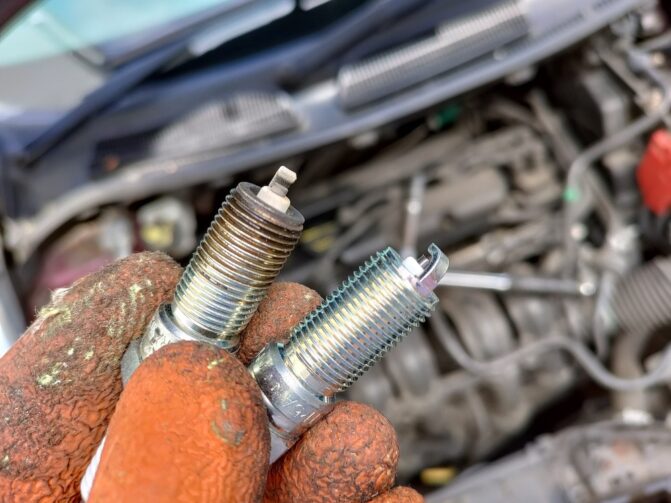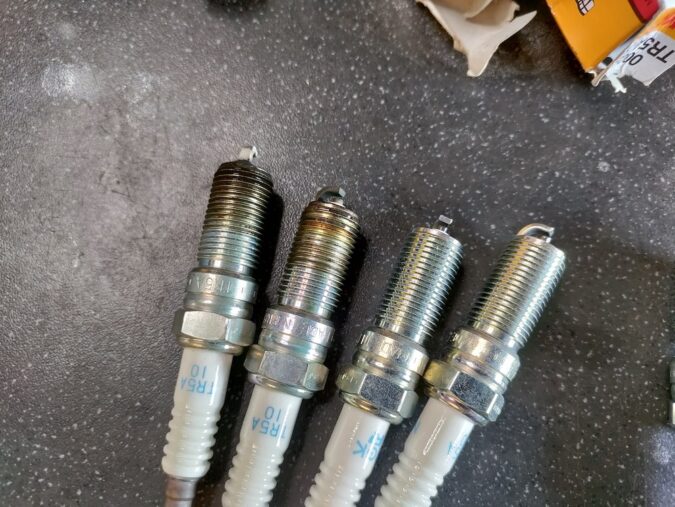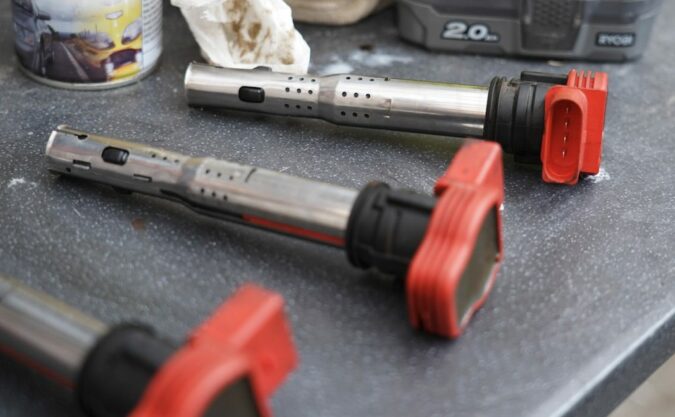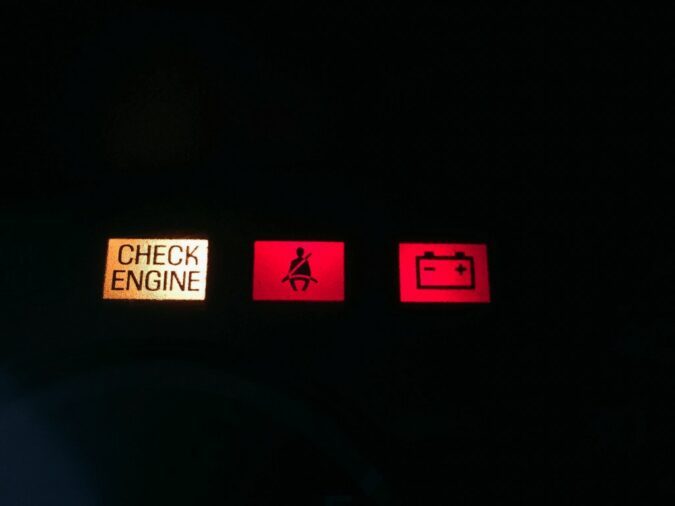Are you getting a cylinder 1 misfire and the code P0301 and you want to learn more about how to tackle this problem? Well, if this is the case, then you are at the right place because, in this article, there will be quite a lot to cover on this topic.
Doing your own research before you go out there and try to solve the problem is always a good idea. You just don’t want to spend hundreds of dollars on expensive mechanics when in some cases, the problem is mainly caused by a simple spark plug.
But what if I told you that there are certain conditions inside of the combustion that can aggravate spark plug failure and make the spark plug fail much sooner? Sometimes the root of these problems is much deeper than we previously thought.
It is not black and white as many people think. And this is why we are here to help you to determine the causes of this problem. First, we are going to learn what is car diagnostics, and then we will cover what is an engine misfire.
We will also elaborate more on the code P0301 cylinder 1 misfire. Once we clear that out of our way, we will cover the causes, symptoms, and diagnostics processes that can be done to tackle this problem. So, without further ado, let’s dive into the topic.
Car Diagnostics
Now before we dive into the cylinder 1 misfire, let’s take a look at car diagnostics and learn more about this process and how it is done the right way. There are people facing similar issues and when it comes to problems like these, you just need to have a basic grasp of knowledge when it comes to tackling problems of your car.
As you probably know, modern cars are very complex. They pack a lot of different components that communicate with the PCM. The PCM is simply known as the Powertrain Control Module. This module is the brain of the whole car, in other words, the car computer.
And this device is constantly communicating with different sensors and other electronic components and then based on the data that this device collects will trigger a code. Like in our case when you have a cylinder 1 misfire.
And in order to read what the check engine light means, you need to have a tool known as an OBD2 scanner. The OBD2 scanner will let you scan the car for codes. This tool is essential if you want to be your own mechanic. You cannot do anything without a code reader. And you can find these tools on the cheap on Amazon or similar sites.
The second tool you will need will be the multimeter. Since cheap OBD2 scanners don’t give you the ability to read live data, you will need to get a multimeter to bench-test sensors and different components of your car.
With a multimeter, you can measure different properties like voltage, resistance, and continuity. So, this tool is highly recommended to have. But what about the cylinder 1 misfire? More about that, we will cover next.
Engine Misfire
Now before we dive into the P0301 code and the cylinder 1 misfire problem, let’s first take a look at what is a cylinder misfire in general. Since this is a topic that confuses a lot of people out there and people are just not able to tell if their car is misfiring or not. So, let’s cover this in detail.
An engine misfire in general is a missed combustion. The gas inside of the cylinder simply does not ignite on time.
In the internal combustion engine, everything has to be perfectly timed out. These are 4-stroke engines and for each stroke, there is a certain procedure. And if the ignition is not timed well, the engine will misfire.
For example, the gas can be ignited prematurely while the piston is not at the end of the stroke. And this premature ignition can lead to misfires and a situation known as an engine knock. Because in this case, there could be two parallel bangs, and when they collide, it will cause the engine to start knocking.
And there could be also delayed combustion and the engine does not ignite with the help of the spark plug but because of the compression. Which is also a bad thing. This problem is often caused by worn-out spark plugs or other ignition issues.
But how these misfires are represented? Well, most often, these misfires are represented as engine ticking or ticks or coming from the top of the engine (not to be confused with a lifter tick). Especially if it happens on a certain cylinder, you will be able to pick it up.
Also, there will be some pops and bangs on the exhaust pipe, and the gas flow will not be very smooth. But what about the cylinder 1 misfire? More about that we will cover next.
P0301 Cylinder 1 Misfire Detected
Now let’s elaborate more on the cylinder 1 misfire and see what is this problem all about. We will specifically focus on the code P0301 code. So, what is the meaning of the P0301 code?
The P0301 is a generic DTC code that can be triggered on any OBD2 vehicle produced after 1996. The basic definition is “P0301 Cylinder 1 Misfire Detected”. So, what does this mean in the first place?
Well, this code indicates a misfire on cylinder number 1. Misfire codes start with P0300, which indicates a random engine misfire. But the P0301 or P0302 indicate a misfire on a specific cylinder.
This in our opinion is a great lead when it comes to solving the problem since it does not happen randomly in your engine. But only cylinder 1 is the one that is affected by this type of work.
And as we noted previously, a misfire is a situation where your spark does not work well. There can be premature combustion, delayed combustion, or no combustion at all since the spark plug does not produce any spark.
And you will be able to experience some of the symptoms that are associated with this problem, which honestly are not that nice since your engine will not work as it should because of this problem. But more on the symptoms we are going to elaborate later on.
What is worth noting is that there could also be other codes, such as:
- P0300 Code (or make/model specific ones, such as P0300 Nissan or P0300 Chevy)
- P0301 Code
- P0302 Code (a cylinder 2 misfire)
- P0303 Code
- P0304 Code (a cylinder 4 misfire)
- P0305 Code
- P0306 Code
You get the idea. Each number refers to a certain cylinder. And in our case, as we noted P0301 means cylinder 1 misfire. And what are the causes of this problem? Well, more on that, we are going to elaborate in the following chapter.
Cylinder Misfire Causes
Now that we elaborated more on the cylinder 1 misfire problem and learned that the cylinder ignition is not functioning well on cylinder number 1.
We think that now it is time to dive into the causes of this problem and learn more about what could be causing the problem with your car. There could be a number of different reasons behind it, hence, why some folks wonder whether can bad gas cause a misfire, so let’s cover them in detail and see what could be the problem.
Cylinder 1 Misfire Causes #1: Bad Spark Plug
The first and most common symptom of a cylinder 1 misfire is the situation with the spark plug. This is probably one of the first components that you should check before you do something else to the car.
Spark plugs can fail, and the electrode can get damaged or covered in oil, coolant, or carbon. So, when this happens, the ignition will not be particularly good. The spark plug can even stop working completely. Therefore, you need to be on the lookout for the symptoms of a bad spark plug.
This is why you need to check the spark plug and the condition (and learn how to read spark plugs). A spark plug can tell a lot of stories about how your engine is working. Each condition leads to a different root of the failure cause. For more references, check out our guide on how to check your spark plugs, as well as what does a bad spark plug look like.
Otherwise, you might have issues such as there being oil in the spark plug well, or if there’s generally any motor oil on the spark plug. If so, you’ll then have to consider the cost of a replacement spark plug. Now let’s move on to the next cylinder 1 misfire causes.
Cylinder 1 Misfire Causes #2: Bad Spark Plug Wire Or Distributor
Next on our list of cylinder misfire causes is the bad spark plug wire or distributor. Older cars until the late 90s used distributor and wires for ignition timing.
So, what can happen is that these components can fail and cause problems. So, if your car is an old-school model, you should check the condition of these components as well. You can check this by removing the spark plug and plugging it into the wire, then crank the car.
Then if you put the spark near metal it should create a spark. If it doesn’t create a spark, the wire or distributor is bad and causing cylinder 1 to misfire. So, remember to be wary of the symptoms of a bad distributor.
Cylinder 1 Misfire Causes #3: Bad Ignition Coil
The next common cause for the cylinder number 1 misfire is the situation with the bad ignition coil. Modern cars are using something known as coil-on-plug or simply as a coil pack.
This means that for each cylinder, you have a spark plug and on top of the spark plug an ignition coil. This coil is basically an electric transformer that transforms the low 12v current into a high voltage current and makes the spark plug work.
So, when a coil is dead, it means that there is a problem. As such, it’s crucial that you identify the symptoms of a bad ignition coil (such as P0351 codes), and learn how to test a coil pack with a multimeter, as well as consider the cost of a replacement ignition coil.
And this problem is often a cylinder 1 misfire or a misfire on another cylinder that is affected.
Cylinder 1 Misfire Causes #4: Bad Fuel Injector
The next probable cause for the cylinder 1 misfire is the bad fuel injector. Each cylinder has a fuel injector and this injector as you know injects fuel.
And these injectors can be somewhat problematic, thus showcasing the symptoms of a bad fuel injector. Especially on modern cars with direct injection. Even the slightest imperfections, such as dirty fuel injectors, when it comes to spraying the fuel in the cylinder can cause the engine to misfire.
So, if you own a Kia or a VW, Audi, or a similar brand, you will have a hard time with issues like these. If the issue isn’t too serious, you could simply use the best fuel injector cleaner (with some tips on how to clean fuel injectors) to clear up any clogs. Elsewhere, you might otherwise have to consider the cost of a replacement fuel injector.
What is worth noting is that when an injector is malfunctioning, there will be another code in most cases which will help you diagnose the cylinder 1 misfire.
Cylinder 1 Misfire Causes #5: Burnt Valves
The next very common cause that we are going to discuss when it comes to the cylinder 1 misfire is the situation when you have damaged or burnt engine valves.
And this is a very common situation and a big problem for a lot of people. When engine valves do not create a perfect vacuum seal, your combustion is not that great.
And valves can get damaged and cause these problems. For this purpose, you will have to make a compression test on your car. And then determine what could be causing the cylinder 1 misfire on your car. Now let’s move on to the next common cause for this problem.
Cylinder 1 Misfire Causes #6: Carbon Buildup
The next common cause of cylinder 1 misfire is carbon buildup. Carbon buildup can be created both on the piston head, as well as on the valves.
And this carbon is really a problem because it can cause a cylinder 1 misfire on your car. As we noted previously, carbon can prevent the valves from sealing well.
As well as a lot of crust on the piston head top surface could create some abnormal explosions. So, this is one of the very common causes of this problem.
Cylinder 1 Misfire Causes #7: Low Compression
The next probability for this cylinder 1 misfire problem is the low compression. As we noted previously, when you have poor compression, you also have poor combustion.
We noted that the valves can not close and cause a problem. But there could be other causes (not to mention symptoms) for low compression.
Namely, poor sealing piston rings. So, if the pistons do not seal well and have some slack between the cylinder wall and the pistons, you will have a difficult time. But more on this, we are going to elaborate later on.
Cylinder 1 Misfire Causes #8: Defective PCM
The next common cause for this cylinder 1 misfire problem is a defective PCM. PCM as you probably know is the Powertrain Control Module. This computer is the brain of the car and this component regulates a lot of things happening inside the engine.
And if this component for some reason become faulty, it will trigger the check engine light quite often and the P0301 code and other similar codes can be present. Now let’s move on to the last causes.
Cylinder 1 Misfire Causes #9: Other Miscellaneous Causes
Now let’s cover the other less common problems that can trigger a cylinder 1 misfire. We decided to add them in a separate chapter since they are less common to occur.
Namely, other problems that can trigger this code can be a clogged EGR valve, vacuum leaks, poor fuel flow, leaking head gasket, camshaft sensors, crankshaft sensor, oxygen sensor, throttle position sensor, catalytic converter, MAF sensor, MAP sensor.
So, we covered the causes of the cylinder 1 misfire, and now let’s dive into the symptoms associated with the problem.
Engine Misfire Symptoms
Now that we know the causes of the cylinder 1 misfire. Let’s take a look at the symptoms that are closely associated with this problem and learn more about what you can expect symptom-wise from the car.
One of the first symptoms that you will notice is the check engine light. There should be a code P0301. But also, if the problem with the coil, or any other sensor there will be codes concerning these components as well.
Other conditions can include difficulty starting the engine, rough idle, vibrations on the steering wheel, hesitation, loss of power, increased gas consumption, and engine stalling.
As you can tell, this is a serious problem that could put the reliability of your car under question. This is why you need to make sure that you diagnose the problem. And how you can diagnose the cylinder 1 misfire, we are going to elaborate in the following chapter.
Diagnosing Misfire
Now let’s learn how you can diagnose a cylinder 1 misfire. For this purpose, you will need a special tool known as an OBD2 scanner or code scanner as some people call it.
This tool will give you all the necessary data that you need to troubleshoot the problem. So, in this case, you get a P0301 code that indicates a cylinder 1 misfire.
Besides this code, there will be also other codes as well. For example, a code concerning the ignition coil, injector, O2 sensor, and MAF sensor. All these codes are precious data when it comes to overcoming this problem.
So, you have to pay attention to them since this problem is likely triggered by some of these components. Then you should troubleshoot the respective component with a multimeter and see if it’s working well or not.
Once you have tested the component, you can replace it with a new one, clear the codes and the check engine light will disappear from your cluster and your car will regain proper function and there will be no more cylinder 1 misfire.
Cylinder 1 Misfire Fix
So, we learned what is the cylinder 1 misfire and how you can diagnose this problem with an OBD2 scanner. Now let’s take a look at what you can do without a scanner, how you can fix this misfire?
Well, in this case, I would advise that you first check the spark plug and the condition of the spark plug.
Remove the coil or wire and see the condition of the electrode. If the electrode is missing some pieces or is covered in oil or smells of gas, clean it well and try if this sorts out the problem. If it doesn’t, then replace the spark plug and this should hopefully fix the problem.
Or if the problem is caused by an ignition coil, what you can do is swap the ignition coils and then see if this cylinder misfire appears on the cylinder where you installed the coil from cylinder number 1. This is a very simple and effective method to test an ignition coil.
If the problem is caused by something else, you will need to do more thorough work and diagnostics. Therefore, the cost of fixing an engine misfire can vary quite a bit.
Driving With Misfiring Cylinder 1
Now let’s take a look at the cylinder 1 misfire and whether you can drive with a misfiring cylinder or not. Should you do it?
Well, you can do it, anything is possible but the chance of the car stalling is rather big. Especially if you have a small engine with four cylinders. The car will be very underpowered under these circumstances and you can be left out stranded somewhere.
So, your best bet would be to fix the problem with the misfires. That’s how you will be safe from issues that can be even more frustrating.
Cylinder 1 Misfire: In Conclusion…
In this article, we have covered quite a bit when it comes to the cylinder 1 misfire. First, we discussed car diagnostics and how this procedure is done. Then we elaborated on the cylinder 1 misfire and the code P0301.
Then we learned more about the causes, and symptoms, and also how to diagnose the problem with the misfire on cylinder number 1. Lastly, we learned if you can keep driving like this.
FAQs On Cylinder 1 Misfire
Now let’s answer some frequently asked questions.
What Is A Misfire
A misfire in simple words is abnormal combustion. Each cylinder should fire at the right time. And if the cylinder does not fire on time, there will be a situation known as a misfire. That is represented as a ticking noise coming from the engine and also there will be pops and bangs from the exhaust.
What Does Misfiring Mean
When a car is misfiring it means that some of the cylinders do not create combustion when they should. Sometimes this combustion is delayed or premature. And this is a situation known as misfiring.
What Causes A Misfire
A misfire can be caused by a lot of things. The most common causes of this problem are spark plugs and ignition coils. But this problem can be also caused by bad wires and distributor in older cars. Also, bad injectors, burnt or leaky valves, low compression, and carbon deposits. These are the most common causes
Can Spark Plugs Cause Misfire
Yes, definitely, a spark plug will make your engine misfire and you will have a problem with the combustion in your engine. So, replacing the spark plugs is recommended after 60,000 miles.
How To Diagnose A Misfire
A misfire can be diagnosed with a multimeter. There will be codes starting from P0300 which indicates a random misfire. There are other codes like P0301, P0302, P0303, and so on. These codes indicate a misfire for a specific cylinder. And in order what is causing the misfire you will have to do some troubleshooting when it comes to the spark plugs and coils. These are the most common reasons for engine misfires.
How To Fix Engine Misfire
Fixing this problem is simple, just check the spark plugs and see the condition, if they are old or dirty, replace them with new ones. If you get a code for the coils, just swap out the coils and see if the code reappears on the other cylinder. If the code moves to the other cylinder, you know that it is a coil issue. There could be other causes for this problem and the fixes are different for them. But these are the most common ones.




